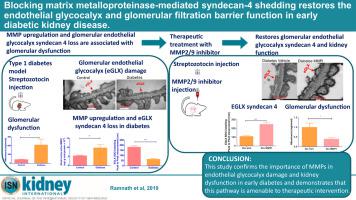当前位置:
X-MOL 学术
›
Kidney Int.
›
论文详情
Our official English website, www.x-mol.net, welcomes your
feedback! (Note: you will need to create a separate account there.)
Blocking matrix metalloproteinase-mediated syndecan-4 shedding restores the endothelial glycocalyx and glomerular filtration barrier function in early diabetic kidney disease.
Kidney International ( IF 14.8 ) Pub Date : 2019-11-02 , DOI: 10.1016/j.kint.2019.09.035 Raina D Ramnath 1 , Matthew J Butler 1 , Georgina Newman 1 , Sara Desideri 1 , Amy Russell 1 , Abigail C Lay 1 , Chris R Neal 1 , Yan Qiu 1 , Sarah Fawaz 1 , Karen L Onions 1 , Monica Gamez 1 , Michael Crompton 1 , Chris Michie 1 , Natalie Finch 1 , Richard J Coward 1 , Gavin I Welsh 1 , Rebecca R Foster 1 , Simon C Satchell 1
Kidney International ( IF 14.8 ) Pub Date : 2019-11-02 , DOI: 10.1016/j.kint.2019.09.035 Raina D Ramnath 1 , Matthew J Butler 1 , Georgina Newman 1 , Sara Desideri 1 , Amy Russell 1 , Abigail C Lay 1 , Chris R Neal 1 , Yan Qiu 1 , Sarah Fawaz 1 , Karen L Onions 1 , Monica Gamez 1 , Michael Crompton 1 , Chris Michie 1 , Natalie Finch 1 , Richard J Coward 1 , Gavin I Welsh 1 , Rebecca R Foster 1 , Simon C Satchell 1
Affiliation

|
The endothelial glycocalyx is a key component of the glomerular filtration barrier. We have shown that matrix metalloproteinase (MMP)-mediated syndecan 4 shedding is a mechanism of glomerular endothelial glycocalyx damage in vitro, resulting in increased albumin permeability. Here we sought to determine whether this mechanism is important in early diabetic kidney disease, by studying streptozotocin-induced type 1 diabetes in DBA2/J mice. Diabetic mice were albuminuric, had increased glomerular albumin permeability and endothelial glycocalyx damage. Syndecan 4 mRNA expression was found to be upregulated in isolated glomeruli and in flow cytometry-sorted glomerular endothelial cells. In contrast, glomerular endothelial luminal surface syndecan 4 and Marasmium oreades agglutinin lectin labelling measurements were reduced in the diabetic mice. Similarly, syndecan 4 protein expression was significantly decreased in isolated glomeruli but increased in plasma and urine, suggesting syndecan 4 shedding. Mmp-2, 9 and 14 mRNA expression were upregulated in isolated glomeruli, suggesting a possible mechanism of glycocalyx damage and albuminuria. We therefore characterised in detail the activity of MMP-2 and 9 and found significant increases in kidney cortex, plasma and urine. Treatment with MMP-2/9 inhibitor I for 21 days, started six weeks after diabetes induction, restored endothelial glycocalyx depth and coverage and attenuated diabetes-induced albuminuria and reduced glomerular albumin permeability. MMP inhibitor treatment significantly attenuated glomerular endothelial and plasma syndecan 4 shedding and inhibited plasma MMP activity. Thus, our studies confirm the importance of MMPs in endothelial glycocalyx damage and albuminuria in early diabetes and demonstrate that this pathway is amenable to therapeutic intervention. Hence, treatments targeted at glycocalyx protection by MMP inhibition may be of benefit in diabetic kidney disease.
中文翻译:

阻断基质金属蛋白酶介导的 syndecan-4 脱落可恢复早期糖尿病肾病的内皮糖萼和肾小球滤过屏障功能。
内皮糖萼是肾小球滤过屏障的关键组成部分。我们已经表明,基质金属蛋白酶 (MMP) 介导的聚糖 4 脱落是体外肾小球内皮糖萼损伤的一种机制,导致白蛋白通透性增加。在这里,我们通过研究链脲佐菌素诱导的 DBA2/J 小鼠 1 型糖尿病,试图确定这种机制在早期糖尿病肾病中是否重要。糖尿病小鼠出现白蛋白尿,肾小球白蛋白通透性增加,内皮糖萼受损。发现 Syndecan 4 mRNA 表达在分离的肾小球和流式细胞术分选的肾小球内皮细胞中上调。相反,糖尿病小鼠的肾小球内皮管腔表面聚糖 4 和 Marasmium oreades 凝集素凝集素标记测量值降低。同样,syndecan 4 蛋白表达在离体肾小球中显着降低,但在血浆和尿液中增加,表明 syndecan 4 脱落。Mmp-2、9 和 14 mRNA 表达在分离的肾小球中上调,表明糖萼损伤和蛋白尿的可能机制。因此,我们详细描述了 MMP-2 和 9 的活性,并发现肾皮质、血浆和尿液显着增加。用 MMP-2/9 抑制剂 I 治疗 21 天,在糖尿病诱导后六周开始,恢复了内皮糖萼的深度和覆盖范围,减轻了糖尿病引起的白蛋白尿并降低了肾小球白蛋白通透性。MMP 抑制剂治疗显着减弱肾小球内皮和血浆多聚糖 4 脱落并抑制血浆 MMP 活性。因此,我们的研究证实了 MMPs 在早期糖尿病的内皮糖萼损伤和白蛋白尿中的重要性,并证明该途径适用于治疗干预。因此,通过抑制 MMP 来保护糖萼的治疗可能对糖尿病肾病有益。
更新日期:2019-11-02
中文翻译:

阻断基质金属蛋白酶介导的 syndecan-4 脱落可恢复早期糖尿病肾病的内皮糖萼和肾小球滤过屏障功能。
内皮糖萼是肾小球滤过屏障的关键组成部分。我们已经表明,基质金属蛋白酶 (MMP) 介导的聚糖 4 脱落是体外肾小球内皮糖萼损伤的一种机制,导致白蛋白通透性增加。在这里,我们通过研究链脲佐菌素诱导的 DBA2/J 小鼠 1 型糖尿病,试图确定这种机制在早期糖尿病肾病中是否重要。糖尿病小鼠出现白蛋白尿,肾小球白蛋白通透性增加,内皮糖萼受损。发现 Syndecan 4 mRNA 表达在分离的肾小球和流式细胞术分选的肾小球内皮细胞中上调。相反,糖尿病小鼠的肾小球内皮管腔表面聚糖 4 和 Marasmium oreades 凝集素凝集素标记测量值降低。同样,syndecan 4 蛋白表达在离体肾小球中显着降低,但在血浆和尿液中增加,表明 syndecan 4 脱落。Mmp-2、9 和 14 mRNA 表达在分离的肾小球中上调,表明糖萼损伤和蛋白尿的可能机制。因此,我们详细描述了 MMP-2 和 9 的活性,并发现肾皮质、血浆和尿液显着增加。用 MMP-2/9 抑制剂 I 治疗 21 天,在糖尿病诱导后六周开始,恢复了内皮糖萼的深度和覆盖范围,减轻了糖尿病引起的白蛋白尿并降低了肾小球白蛋白通透性。MMP 抑制剂治疗显着减弱肾小球内皮和血浆多聚糖 4 脱落并抑制血浆 MMP 活性。因此,我们的研究证实了 MMPs 在早期糖尿病的内皮糖萼损伤和白蛋白尿中的重要性,并证明该途径适用于治疗干预。因此,通过抑制 MMP 来保护糖萼的治疗可能对糖尿病肾病有益。











































 京公网安备 11010802027423号
京公网安备 11010802027423号